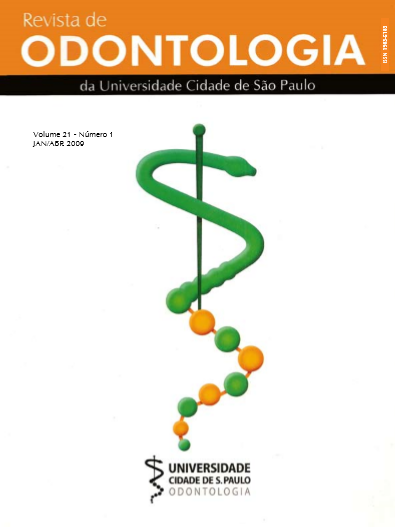Association between respiratory pattern and mandibular morphology
DOI:
https://doi.org/10.26843/ro_unicid.v21i1.431Palavras-chave:
Mouth breathing, Orthodontics, Mandible.Resumo
Introduction: The present study investigates the relationship between respiratory patterns and mandibular morphology. Methods: The study sample comprised 100 pre-orthodontic patients ranging from 8 to 13 years of age. The subject sample was evaluated by clinical examination and lateral cephalometric radiographs. A clinical examination of respiratory patterns categorized the subjects as mouth breathers (Group M, n=52) and nasal breathers (Group N, n=48). Results: The Student t test revealed a statistically significant relationship (p<0.05) between Group M and deep antegonial notch and greater lower anterior facial height. Conclusions: The results of this study suggest that deep mandibular antegonial notch and vertically directed growth pattern are more prominent in individuals who are mouth breathers.Downloads
Referências
Ali IM, Yamada K, Hanada K. Mandibular antegonial and ramusnotch depths and condylar bone change. J Oral Rehabil 2005 Jan; 32(1): 1-6.
Björk A. Prediction of mandibular growth rotation. Am J Orthod 1969 Jun; 55(6): 585-99.
Björk A. The use of metallic implants in the study of facial growth in children: method and application. Am J phys Anthropol 1968 Sep; 29(2): 243-54.
. Fields HW, Warren DW, Black K, Phillips CL. Relationship between vertical dentofacial morphology and respiration in adolescents. Am J Orthod Dentofacial Orthop 1991Feb; 99(2): 147-54.
Kerr WJ, McWilliam JS, Linder-Aronson S, Mandibular form and position related to changed mode of breathing- a five-year longitudinal study. Angle Orthod 1989; 59(2): 91-6.
Kolodziej RP, Southard TE, Southard KA, Casko JS, Jakobsen JR. Evaluation of antegonial notch depth for growth prediction. Am J Orthod Dentofacial Orthop 2002 Apr; 121(4): 357-63.
Lambrechts, AH, Harris AM, Rossouw PE, Stander I. Dimensional differences in the craniofacial morphologies of groups with deep and shallow mandibular antegonial notching. Angle Orthod 1996; 66(4): 265-72.
Linder-Aronson S, Woodside DG, Lundstrom A. Mandibular growth direction following adenoidectomy. Am J Orthod 1986 Apr; 89(4): 273-84.
McNamara JA. Influence of respiratory pattern on craniofacial growth. Angle Orthod 1981 Oct; 51(4): 269-300.
Salem OH, Al-Sehaibany F, Preston CB. Aspects of mandibular morphology, with specific reference to the antegonial notch and the curve of Spee. J Clin Pediatr Dent. 2003; 27(3): 261-5.
Singer CP, Mamandras AH, Hunter WS. The depth of the mandibular antegonial notch as an indicator of mandibular growth potential. Am J Orthod Dentofacial Orthop 1987 Feb; 91(2): 117-24.
Ung N, Koenig J, Shapiro G, Trask G. A quantitative assessment of respiratory patterns and their effects on dentofacial development. Am J Orthod Dentofacial Orthop 1990 Dec; 98(6): 532-32.
Vig PS, Saver DM, Hall DJ, Warren DW. Quantitative evaluation of nasal airflow in relation to facial morphology. Am J Orthod. 1981 Mar; 79(3): 263-72.
Woodside DG, Linder-Aronson S, Lundstrom A, McWilliam JS. Mandibular and maxillary growth after changed mode of breathing. Am J Orthod Dentofacial Orthop 1991 Jul;100(1): 1-18.

